Try this authentic cacio e pepe pasta made with only 3 ingredients! Use the authentic or my simplified method of preparing the sauce to have it perfectly creamy every single time!
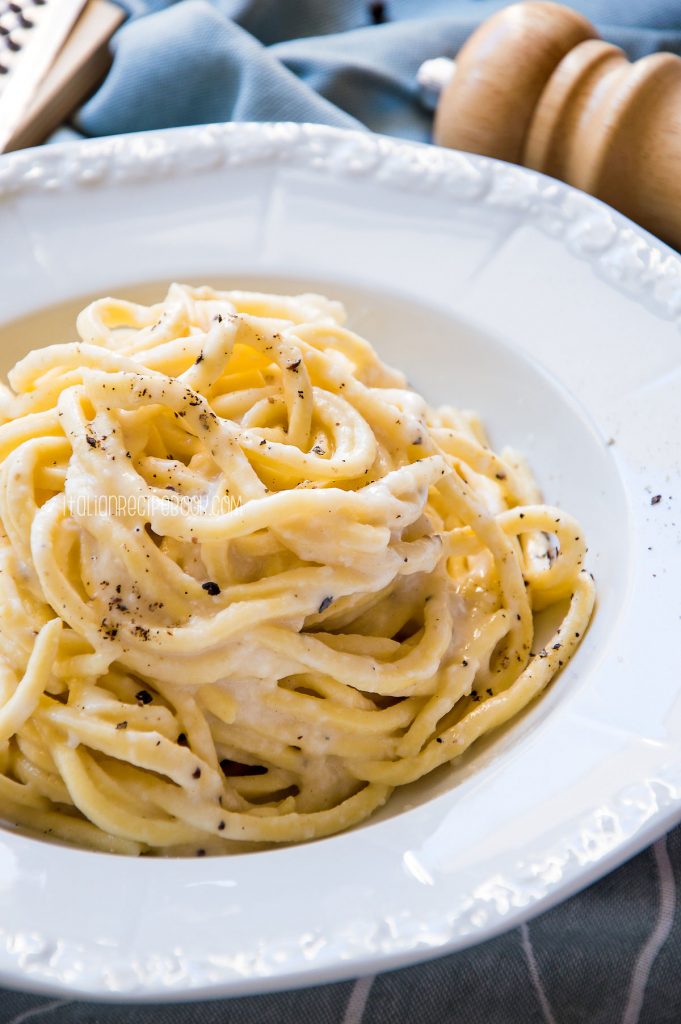
Like spaghetti aglio e olio, it is one of poor man’s dishes or "piatti poveri" in Italian. These are the meals that were prepared by the poorest people, with only few ingredients they could find at home: pasta, cheese (cacio) and black pepper (pepe).
Table Of Contents
Legends Say
According to legends, this dish was anciently cooked by shepherds, during the grazing months.
In that period, those who looked after the sheep had to spend much time away from home, and they couldn't take many ingredients with them. They only had some pasta, a few spices, and, of course, sheep cheese. These are the exact ingredients you’ll need for authentic Cacio e Pepe recipe.
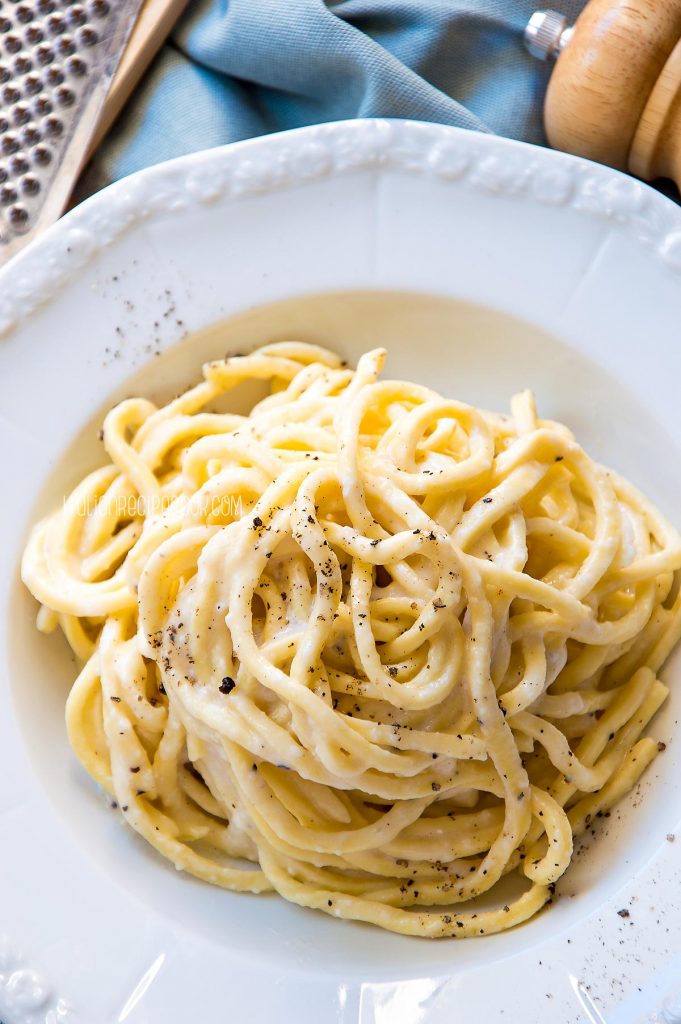
This dish has not changed since ancient times and can be made in less than 15 minutes. All you need to know is a few simple tips and tricks for the best cacio e pepe recipe.
Ingredients & Possible Substitutes
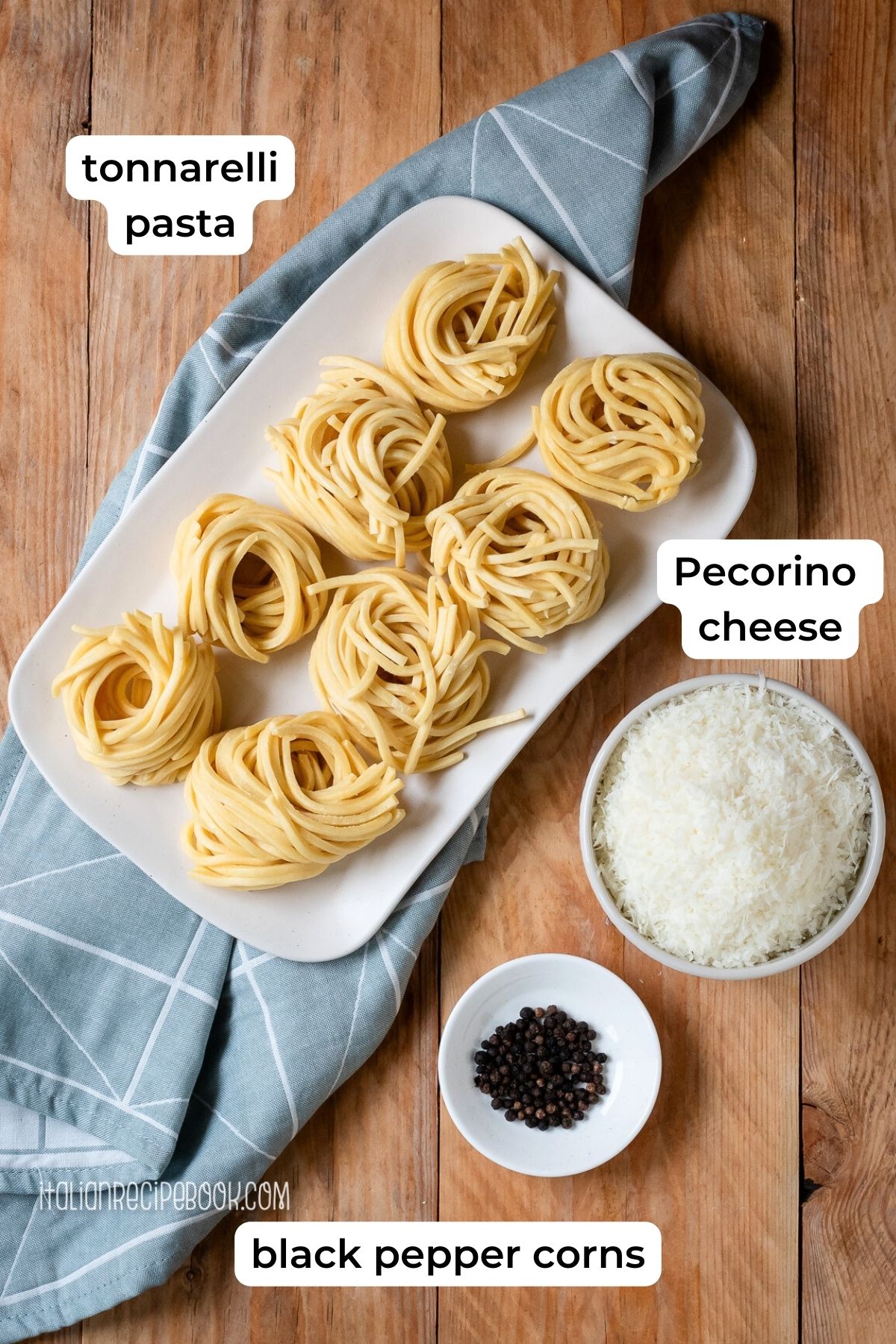
Cacio and pepe pasta has truly minimal ingredients. Even for the famous “midnight spaghetti” aglio olio e peperoncino you’ll technically need “more ingredients”. Well, granted, all of them are pantry items, in contrast to cacio e pepe, where you do need quality Pecorino cheese.
But yes, to make authentic cacio a pepe pasta all you need is ONLY 3 ingredients:
- Tonnarelli Pasta
- Pecorino Romano Cheese
- Whole Black Peppercorns
Tonnarelli Pasta and Its Substitutes
Tonnarelli is an egg pasta type from Lazio. It is shaped like square spaghetti and is usually thicker than the other types of fresh pasta. This quality makes it perfect for any sauce from Central Italy and, of course, for cacio e pepe.
This type of pasta is very easy to find in Rome, but if you live elsewhere it’s much easier to get it online. Or, even better, make tonnarelli pasta at home.
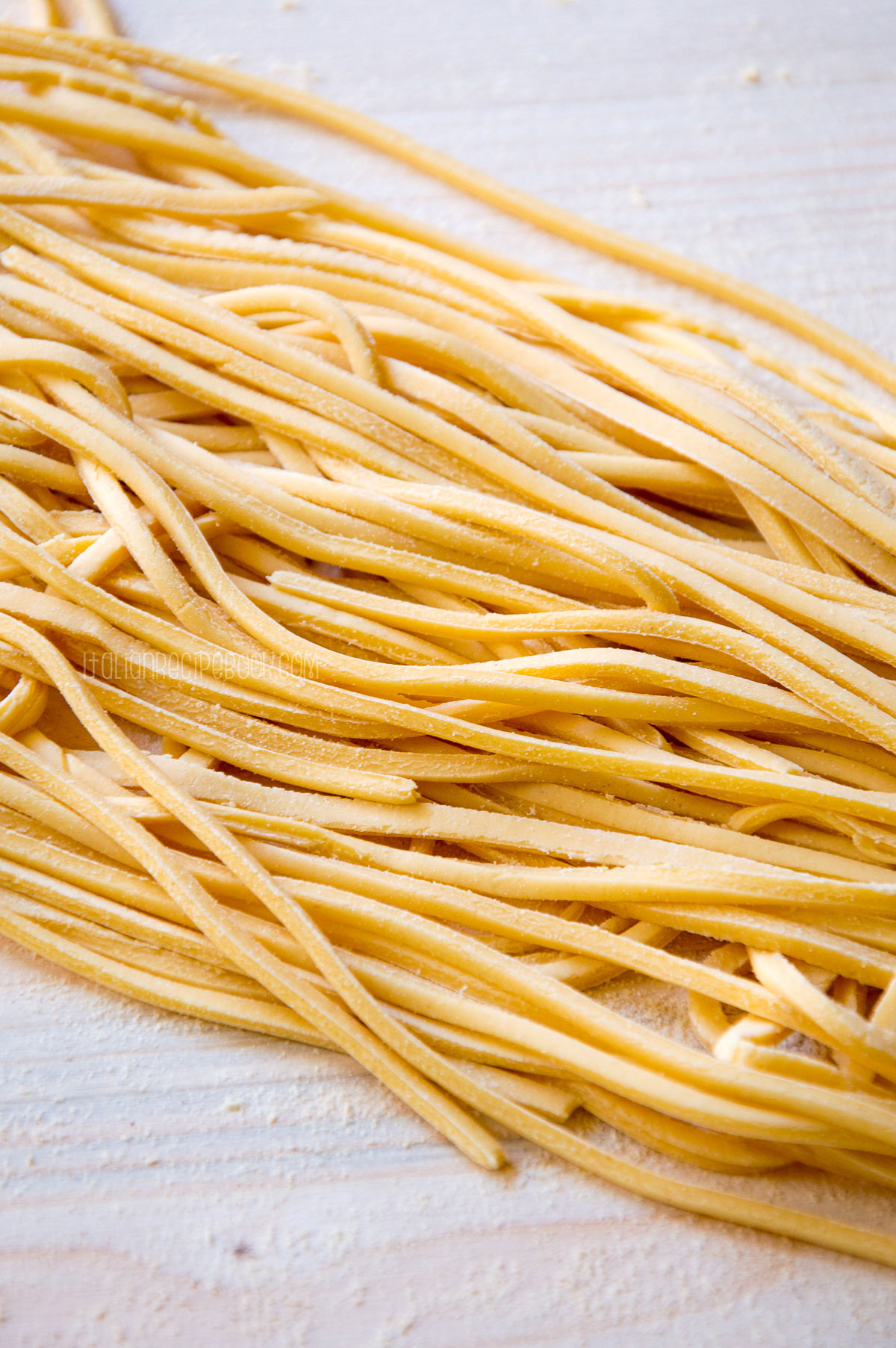
You just need a guitar. No, not the musical instrument: the chitarra (“guitar”) is a traditional tool used for cutting pasta. It’s a very simple instrument, made with two layers of strings on which you can press fresh pasta dough to make tonnarelli, spaghetti, maccheroni, and many others. That’s the reason why tonnarelli are often called “spaghetti alla chitarra”.
Tonnarelli is the most traditional pasta for authentic cacio e pepe. But there are also other alternatives for when you can’t get a hold of this particular kind of pasta.
Your next best choice is Bucatini - long pasta shape similar to thick spaghetti with a hollow center. It’s a great alternative for cacio e pepe because it’s thick and toothy as tonnarelli and the whole that runs through the center of each rod is able to capture even more sauce.
Nice, quality, durum wheat spaghetti will also work great. And some people even like to make it with rigatoni. Make sure it's made with durum wheat flour which not only helps the sauce cling to pasta but also produces the creamiest sauce from the pasta cooking water.
Whole Dried Peppercorns
This simple but yet very important ingredient is one of the protagonists of this dish. It’s best to use whole peppercorns and crush them in a way to make uneven powder with smaller and bigger chunks just when you’re ready to make pasta.
They’ll release an amazing aroma when toasted and pair perfectly with slightly tangy Pecorino cheese. You can use fresh ground pepper if you don’t have whole peppercorns handy.
The amount of pepper is approximate so you might use anywhere between 1 and 2 teaspoon (for 4 servings) depending on your taste. Keep in mind though that pepper is one of the main ingredients and not just a seasoning in this pasta, so you really need to see it and to taste in final dish
Pecorino Romano Cheese
Pecorino Romano cheese is the main ingredient that gives flavor to this pasta, so make sure to choose Pecorino of the highest quality. This is important for two reasons:
- Pretty obvious: the better the cheese, the better the taste.
- Less obvious: low-quality imitations of pecorino are often made by mixing cow's milk and goat's milk. This is a problem both because it goes against the nature of pecorino cheese and because the two types of milk have different proteins, which will react differently to the starch in the cooking water. Cheeses made this way will not make a good cream: there’s a high chance they will curdle and form lumps.
Whenever possible get a whole piece of quality Pecorino Romano cheese and grate it at home. In case, if you want to buy already grated Pecorino cheese make sure you read the list of the ingredients and confirm it contains 100% pecorino cheese (not a mix of different types of cheese with pecorino) and no preservatives.
Also, make sure you use aged Pecorino (distinct sharp taste and firm/hard texture). Fresh or semi-aged Pecorino (mild to taste and softer in texture) simply will not work. It will not create the signature cream but will become stingy!
How To Make - Authentic Method (The Best)
- Bring a pot with water to a boil.
- While you're waiting for it to come to a boil, grate Pecorino cheese and set it aside in a bowl.
- Crush the black peppercorns. Use a mortar or place them in a zip-lock bag and crush using a meat pounder. Aim for medium coarse, uneven grind.
- When the water boils, add little salt and shortly after, tonnarelli pasta.The water should be salted very lightly as the cheese sauce will add the extra saltiness to the final dish. While pasta is cooking prepare the sauce.
- In a large skillet place crushed peppercorns and turn on the heat. Let them toast for a couple of minutes until they start to release the aroma. It's important to stir continuously and not let the peppercorns burn.
- As soon as it starts releasing aroma, add a ladleful of pasta cooking water. The starch from the tonnarelli will react by creating a bubbly foam that will be part of this dish’s signature cream. Do not make the mistake of using plain hot water: only use water from the pot in which you are cooking the tonnarelli.
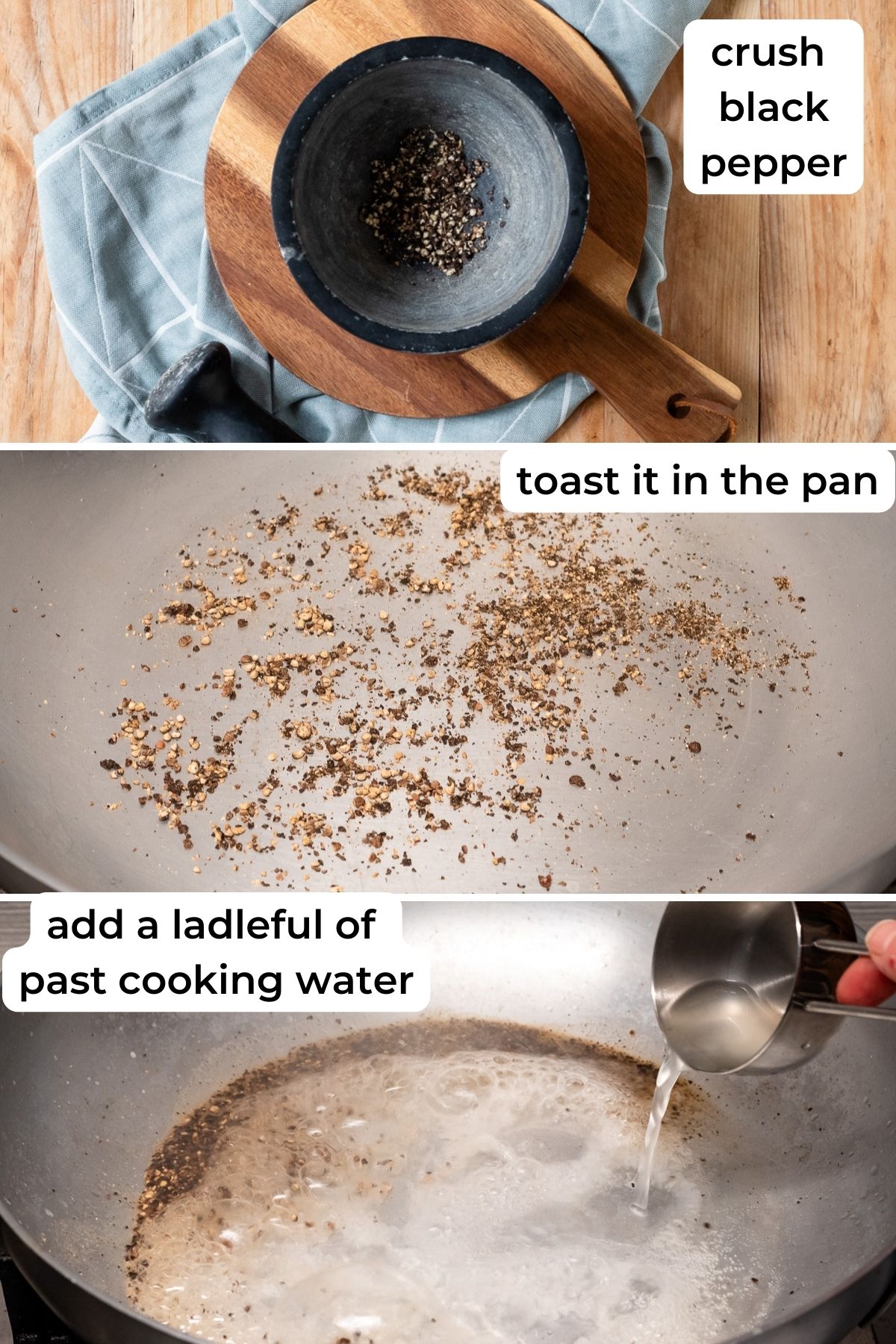
- Add half a ladle of pasta cooking water to the bowl with previously grated pecorino cheese. Stir very quickly. Add a little more cooking water again and keep stirring. In a few seconds, a thick cream should form. It should not be runny! Be careful not to use too much water.
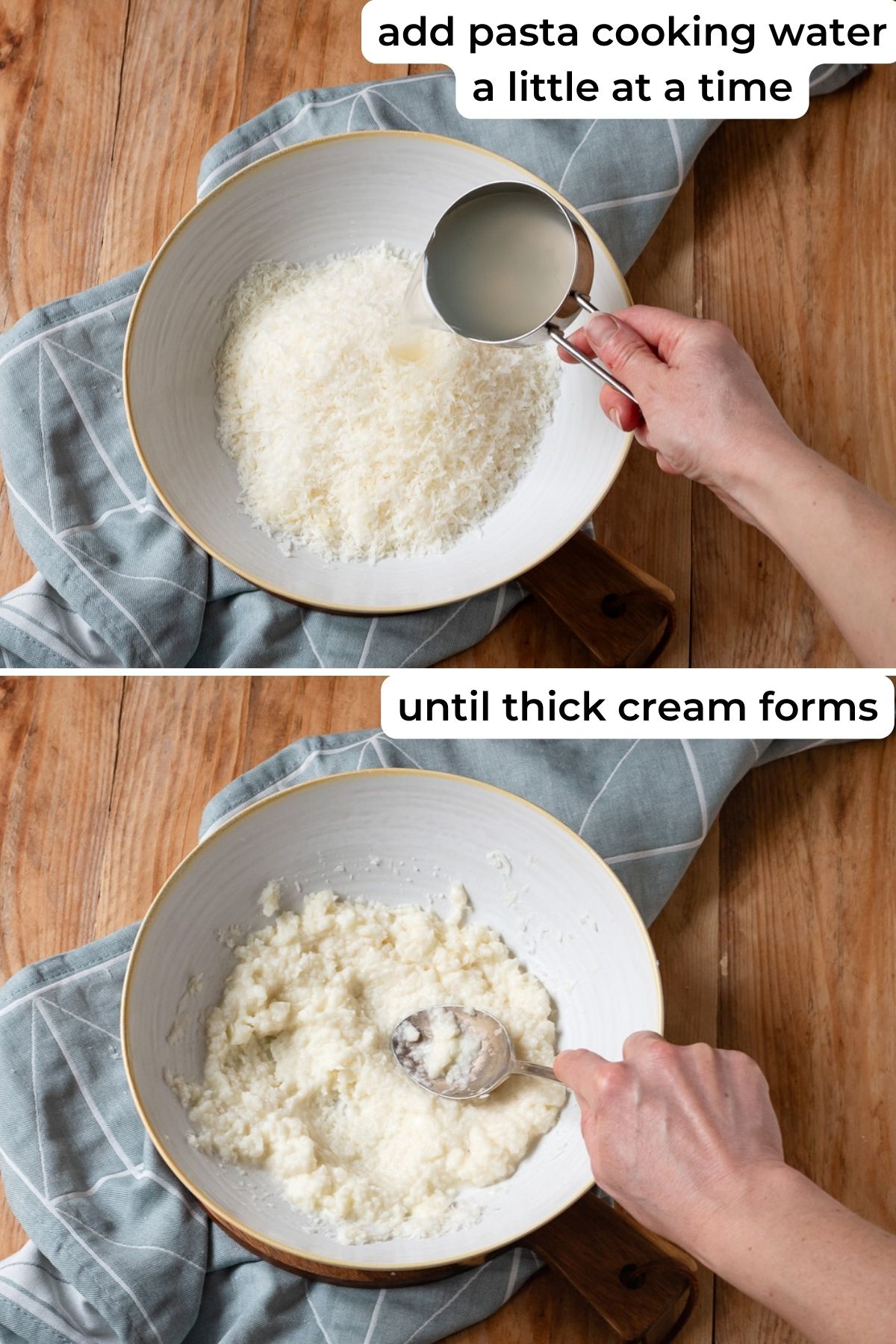
- When the pasta is almost cooked (about 2-3 minutes short of the time stated on the package), drain it (reserve cooking liquid!) and add to the pan with peppercorns. Toss or stir with tongs. The important thing is that it moves in the pan a lot.
- Add a ladleful of pasta cooking water and keep stirring. Add a little more of pasta cooking water if needed. Soon cream will form.
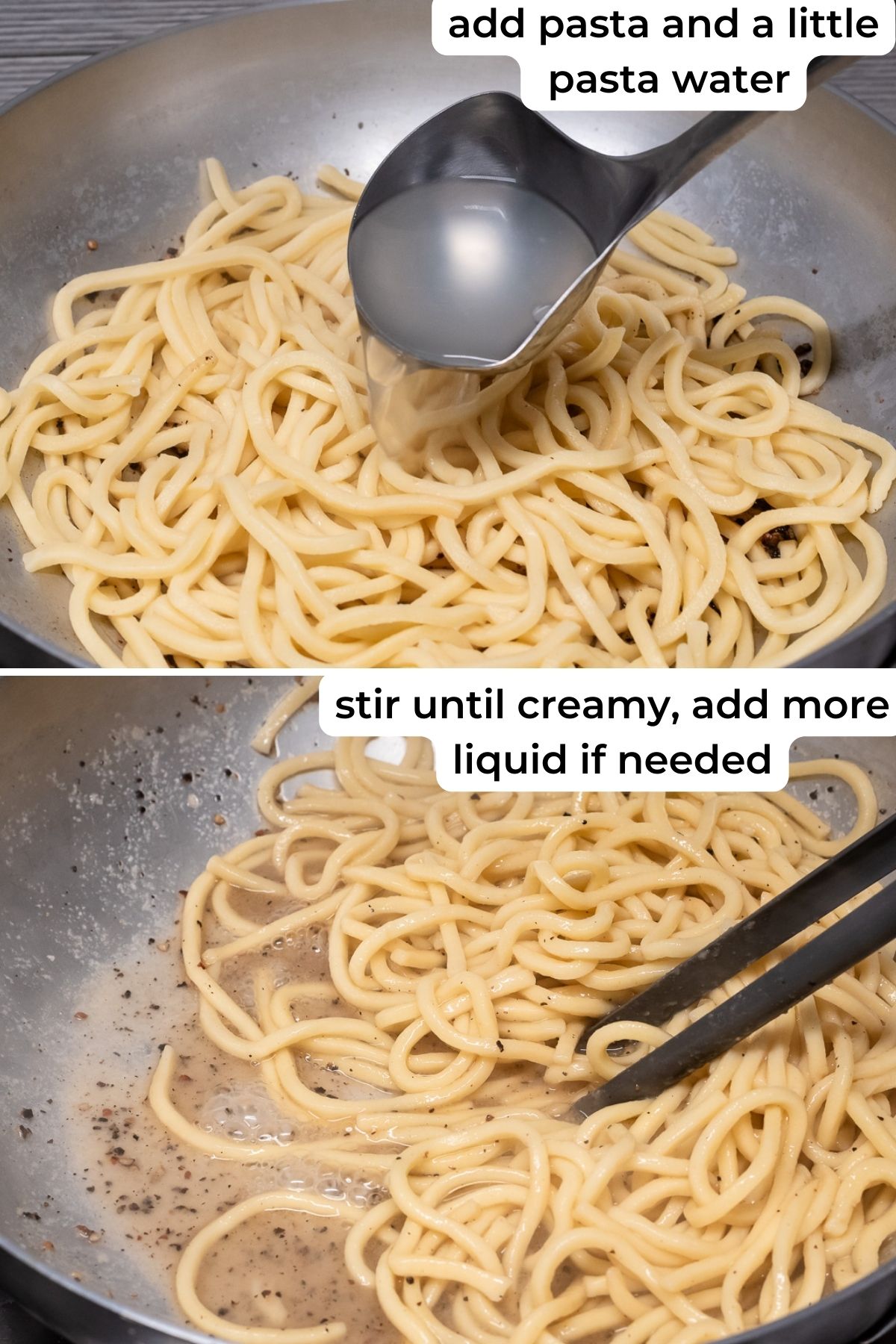
- Turn off the heat and wait for 1-2 minutes.
- Add the Pecorino cream you just made. Keep stirring until cream forms. If the pasta looks too dry, add a little more cooking water, if a little too liquid, add more Pecorino cheese.
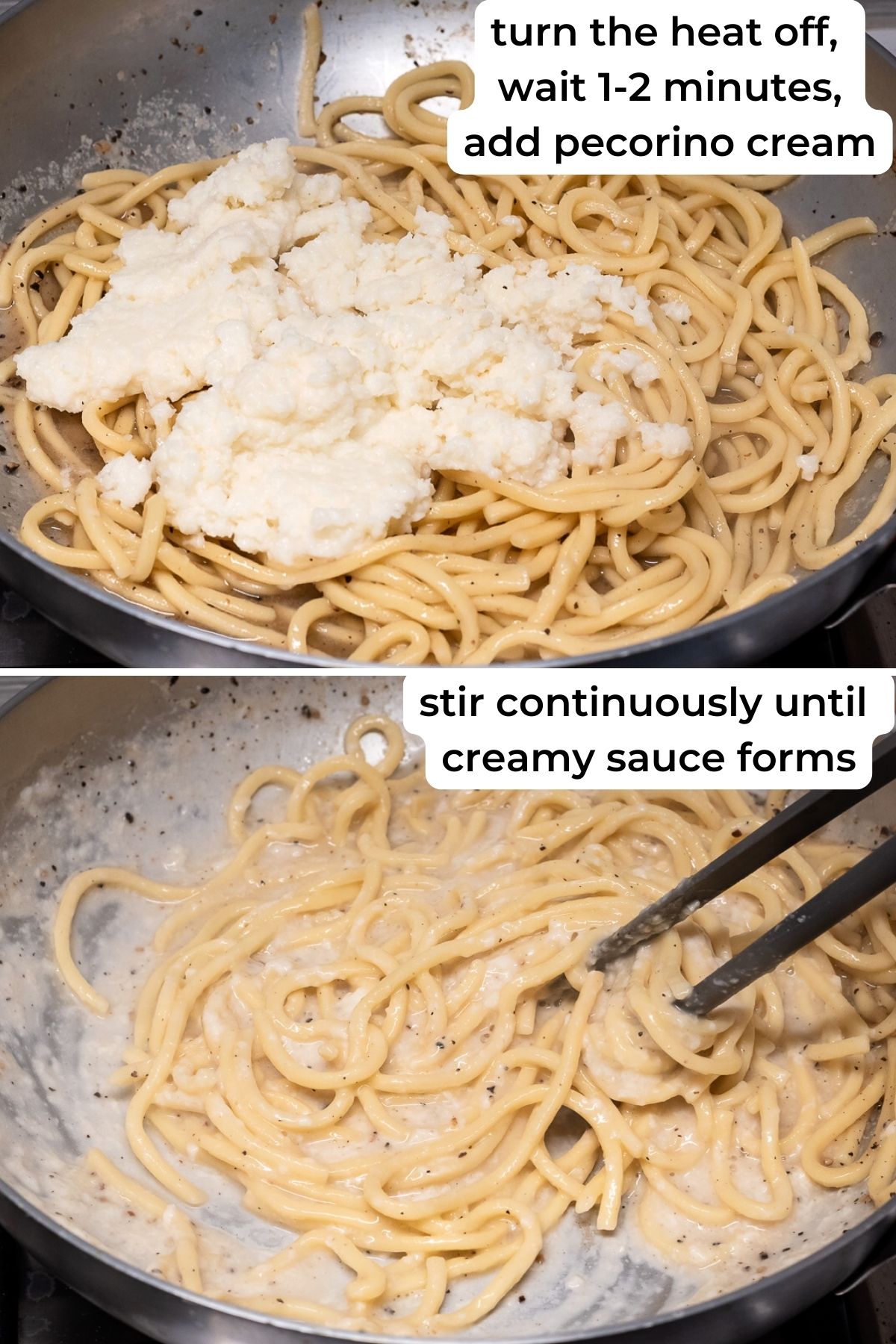
- Serve immediately. Spoon on pasta all the cream from the pan to the last drop.
How To Make - Simplified Methos (The Easiest)
What you’ve just read is the traditional recipe for cacio e pepe pasta. However, there is a simplified way to prepare this dish, which works especially well for anyone making cacio e pepe for the first time.
Here's how it works. Skip the pepper toasting. While the water is boiling, mix the crushed peppercorns with the freshly grated Pecorino cheese in a bowl. When the pasta is ready, pour some of the cooking water into the bowl and prepare a thick cream as shown in the steps above. When pasta is cooked, drain and add it to the bowl. Stir quickly until cream forms, adding a little more cooking liquid if needed.
I'm not sure if I would call it a 100% correct method, because you skip some steps and the result is a little less creamy. Anyway, many people prefer to do it this way because it's faster and requires less attention (and one less pan to wash later). You can try both methods and choose the one the works best for you.
Do's and Don'ts of Perfectly Creamy Cacio e Pepe
- Choose the highest quality Pecorino. Low quality Pecorino might have cow's milk mixed in and/or is not aged enough. All this will lead to curds and lumps instead of creamy sauce.
- Pasta cooking water. Let it cool very slightly. I usually add a ladle to a small bowl first and then to the bowl with cheese. Don't add too much of it. The cream shouldn't be too liquid, as it’ll dissolve quite a lot when added to pasta. It's best to add half a ladleful at a time until you get smooth but still thick consistency. Unfortunately, there's no set amount of cooking water to use, and you'll have to rely on your eyes and experience to figure out if you're using too much, or too little.
- Troubleshooting: In case your Pecorino cream did turn out a little runny when added to the pan with pasta, simply grate a little more Pecorino cheese.
- Never set cacio e pepe pasta on heat once Pecorino has been added. turn the heat on when Pecorino cream has been added to the pan with pasta. Heat will curdle the cheese and instead of signature cream you'll end up with cheese lumps.
- Don't add extra salt. Except for the pasta water. Pecorino cheese paired with some pasta water will provided just the right saltiness to the whole dish.
- Undercook pasta. It will need to cook for another couple of minutes in the pan so cook it 2 minutes less in the water or it'll become too soft in the final dish.
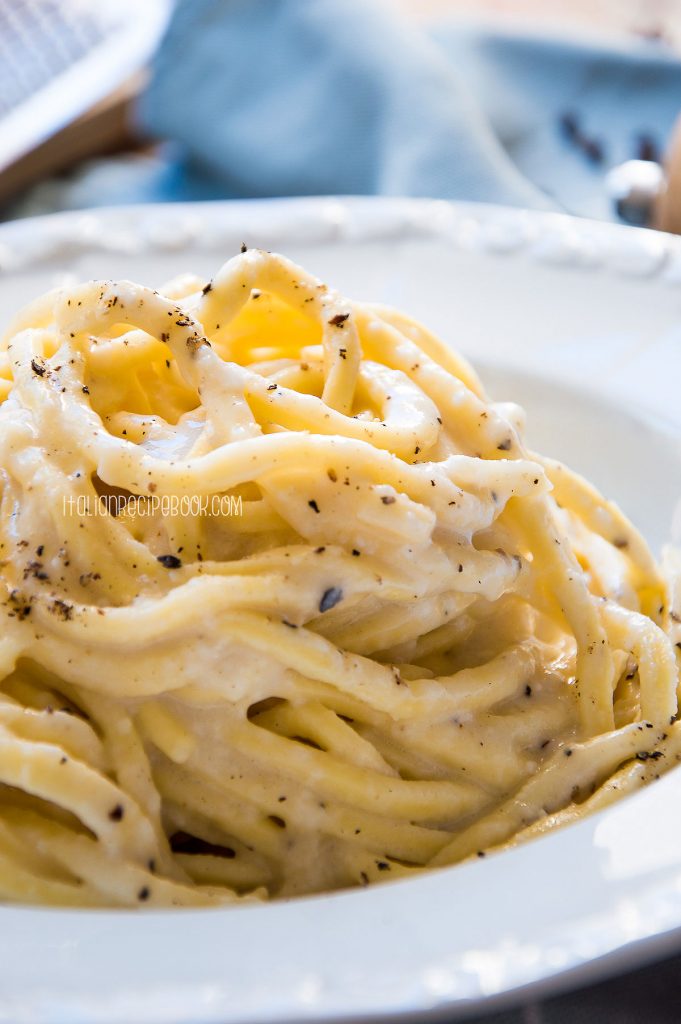
Don't worry if the cream doesn't come out quite right the first time you make it. Pasta cacio e pepe is one of those dishes that you learn by practicing, and in the end, everyone does it their way. You know what they say: practice makes perfect!
Full Recipe
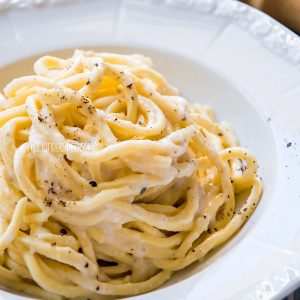
Tonnarelli Cacio e Pepe
Ingredients
- 1 lb tonnarelli , or other long durum wheat pasta, see ingredient notes above
- 3 cups Pecorino Romano cheese , freshly grated (250 grams)
- 1-2 teaspoon of whole dried black peppercorns , see notes above
Instructions
- Bring a pot with water to a boil.
- While you're waiting for it to come to a boil, grate the Pecorino cheese and set it aside in a bowl.
- Crush the black peppercorns in a mortar or place them in a zip-lock bag and crush using a meat pounder. Aim for medium coarse, uneven grind.
- When the water boils, add little salt and shortly after, tonnarelli pasta.The water should be salted very lightly as the cheese sauce will add the extra saltiness to the final dish.
- While pasta is cooking prepare the sauce.
- In a large skillet place crushed peppercorns and turn on the heat.Let them toast for a couple of minutes until they start to release the aroma. It's important to stir continuously and not let the peppercorns burn.
- As soon as it starts releasing aroma, add a ladleful of pasta cooking water. The starch from the tonnarelli will react by creating a bubbly foam that will be part of this dish’s signature cream. Do not make the mistake of using plain hot water: only use water from the pot in which you are cooking the tonnarelli.
- Add half a ladle of pasta cooking water to the bowl with previously grated pecorino cheese. Stir very quickly. Add a little more cooking water again and keep stirring. In a few seconds, a thick cream should form. It should not be runny! Be careful not to use too much water.
- When the pasta is almost cooked (about 2-3 minutes short of time stated on the package), drain it (reserve cooking liquid!) and add to the pan with peppercorns. Toss or stir with tongs. The important thing is that it moves in the pan a lot.Add a ladleful of pasta cooking water and keep stirring. Add a little more of pasta cooking water if needed. Soon cream will form.
- Turn off the heat and wait for 1-2 minutes.
- Add the Pecorino cream you just made. Keep stirring until cream forms. If the pasta looks too dry, add a little more cooking water, if a little too liquid, add more Pecorino cheese.
- Serve immediately. Spoon on pasta all the cream from the pan to the last drop.
Notes
Nutrition
Nutrition information is automatically calculated, so should only be used as an approximation.

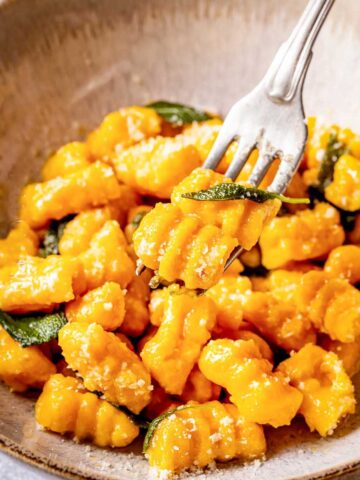
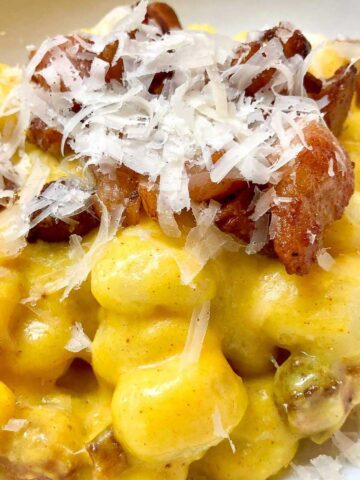
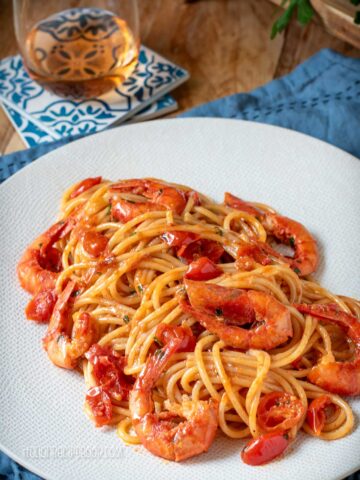
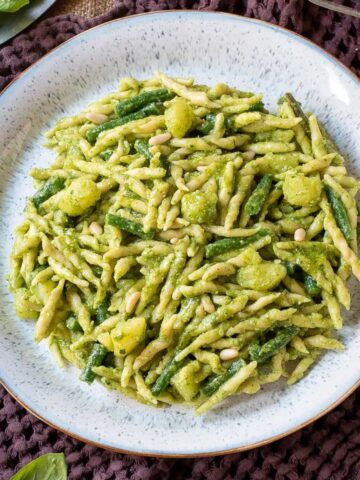
J says
Mine turned into a wad of glue (the cheese). Yes, I used 100% sheep cheese Pecorino Romano.
Italian Recipe Book says
Hey J, this happened to me as well the first time I made them.
At which point did it turn into "glue"?
When you mixed Pecorino with pasta water or one you've added it to the pan?
In any case, if you used high quality cheese it means that the heat was too high for the sauce.
Next time, turn the heat off and let the pan cool for 2-3 minutes. Only then add the cheese and mix.
I'm sure it'll turn out great next time you make it.